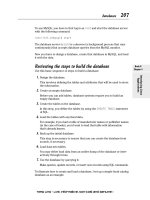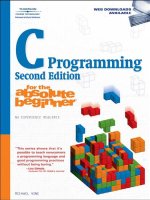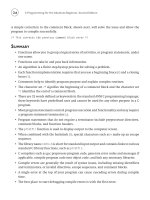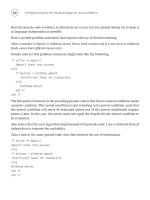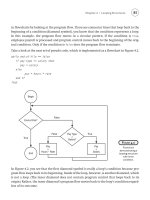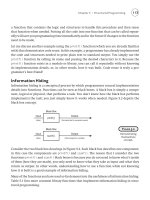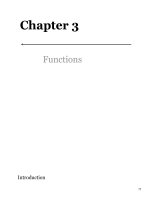C Programming for Scientists & Engineers phần 4 docx
Bạn đang xem bản rút gọn của tài liệu. Xem và tải ngay bản đầy đủ của tài liệu tại đây (1.37 MB, 15 trang )
Introduction
to
executable
statements
39
2.4
Identifying operators
Four
operators
are
frequently
used
in C
programs
to
identify
things:
[]
identifies
an
element
of an
array
fully
qualifies
a
member
of a
data structure
->
provides indirect access
to
members
in a
data
structure whose
address
is
stored
in a
pointer
()
identifies
the
precedence
of
operations
(also
see
Section 2.6)
All
of the
identifying
operators
in the
above
list,
except
for the
last,
have
already been introduced
in
Chapter
1.
However, several
examples
are
given
below
to
reinforce their actions.
Firstly,
the
[ ]
identifier could
be
called
the
'element
operator'
which
is
used
to
identify
a
particular element
of an
array,
as in:
int
A,
B[3];
A
=
B[2J;
assigns
the
value
of the
third element
of
array
B to A
Secondly,
the
'dot
operator',
. , is
used
with
the
name
of a
data
structure
to
access
its
member variables,
as in:
struct
PAIR
Declares
a
template
for a
data
structure
{
(data type)
called
struct
PAIR
int
A;
double
B;
40
C
programming for scientists and engineers
struct PAIR PAIR-
1,
PAIR-2;
intA
=
2,
B
=
9;
Declares two structures
of
type
struct PAIR.
Declares and initializes
A
and
B.
PAIR- 1.A
=
5;
PAIR-l.B=5;
PAIR-2.A
=
10;
PAIR-2. B
=
5;
Assigns the value
5
to
A
in
PAIR-
1.
Assigns the value
5
to
B
in
PAIR-
1.
Assigns the value
10
to
A
in
PAIR-2.
Assigns the value
5
to Bin
PAIR-2.
PAIR-1.B =A;
B= PAIR-l.A;
PAIR-
1.6
=
PAIR-2.A;
PAIR-2.6
=
(PAIR-l.A
+
PAIR-2.A) 'A;
Assigns the value
2
to Bin
PAIR-
1.
Assigns the value
5
to B.
Assigns the value
10
to
Bin
PAIR-
1.
Assigns the value
30
to
Bin
PAIR-2.
In the above example there are three variables calledA and another
three called
B.
In addition to the declaration,
int
A
=
2,
B
=
9;,
two
structures,
PAIR-1
and
PAIR-2,
are declared, each containing
member variables called
A
and
B.
To
access any of the member vari-
ables in the above example, they have been hlly qualified using the
dot operator.
Thirdly, as an alternative to fully qualifying the members of a data
structure, the indirection operator
'->'
can be used if the address
of
the structure has been stored in a pointer. This is demonstrated
below by recoding the previous example.
struct PAIR
{
int A;
double
6;
1;
Declares a template for a data
structure
(data type), called
struct PAIR.
Introduction to executable statements
41
struct PAIR PAIR-
1,
PAIR-2;
struct PAIR 'PAIR- ljtc *PAIR-2-ptr;
Declares
two
structures
of
type
struct
PAIR.
Declares two pointers
of
type
struct PAIR.
intA=2,
B=9;
PAIR- lstr =&PAIR-
1;
PAIR-2jtr =&PAIR-2;
PAIR- Igtr->A
=
5;
PAIR- Ijtr->B
=
5;
PAIR_2jtr->A
=
10;
PAIR_2jtr->B
=
5;
Declares and initializes
A
and
B.
Stores addresses
of
data struc-
tures.
Assigns the value 5 to
A
in
PAIR-
1.
Assigns the value 5 to Bin
PAIR-
1.
Assigns the value
10
to
A
in
PAIR-2.
Assigns the value 5 to Bin
PAIR-2.
PAIR- Igtr->B
=
A;
B
=
PAIR- Ijtr->A;
PAIR- l-ptr->B
=
PAIR_2jtr->A;
PAIR-2jtr->B
=
Assigns the value 2 to Bin
PAIR-
1.
Assigns
the
value 5
to
B.
Assigns the value
10
to
Bin
PAIR-
1.
Assigns the value
30
to Bin
PAIR-2.
(PAIR- Ijtr->A
+
PAIR_29tr->A) *A;
The final identiftring operator in the above list, the precedence
operator,
(
. . .
),
is
new and
is
used to fix the sequence in which other
operators are used in an executable statement. For example, given:
doubleA=
1.0,
B=3.0;
double
C
=
5.0,
D
=
8.0,
E;
E=A+B*C+D;
E=(A+B)*(C+D);
assigns the value 24.0
to
E,
whereas
assigns the value 52.0 to
E
Here, the
two
executable statements involve the same arithmetic
operators and operands, but give different results. In the first
of
the
two
statements, the multiplication operator
takes
default precedence
42 C
programming
for
scientists
and
engineers
over
the
addition
operators.
In the
latter
statement,
the
addition
operations
have
been placed
within
precedence operators,
forcing
them
to
take
precedence
over
multiplication.
Tutorial
2.7
Implement
the dot
operator
example, above,
as a
working
program.
Add a
call
to
fprintf
after
each executable statement
to
display
ALL of the
variables
and
ensure that
the
displayed
values
are
consistent
with
those
given
in the
example. Ensure
that
members
of
data structures
are
accessed
only
by
fully
qualifying
them.
Tutorial 2.8
Implement
the
indirection
operator
example, above,
as a
working
program.
Add a
call
to
fprintf
after
each executable
statement
to
display
ALL of the
variables
and
ensure that
the
displayed
values
are
consistent
with
those
from
the
previous
problem.
Ensure that members
of
data structures
are
accessed indirectly.
2.5
Miscellaneous operators
Three operators
are
considered
here.
The first is the
'contents
of'
operator,
previously
mentioned
in
Section
1.5,
in the
context
of the
pointer
data
type.
The
second
is the sizeof
operator,
used
in
Chapter
1,
Question
1 of the
typical
examination
questions
at the end of the
book.
The final
operator
is
cast,
which
is
used
to
convert
between
different
data
types.
The
'contents
of'
operator
uses
the *
symbol
and
care
must
be
taken
not to
confuse
it
with
the
multiplication
operator.
The
'contents
of'
operator
is
used
to
obtain
the
value
stored
in a
variable
when
the
address
of
that
variable
is
stored
in a
pointer.
For
example:
double
A, B=
1.0,
C =
3.0;
double
*B_ptr, *C_ptr;
A_ptr=&A;
Introduction to executable statements
43
6gtf
=
&
B;
cgtr
=
&C;
A
=
*Bgtr
i
*C>tr;
"Agtf
=
*6-W
+
*Cgtr;
The last
two
statements, above, achieve the same result. In each
case, the 'contents
of'
operator
is
used with pointers that hold the
addresses
of
B
and
C,
to retrieve the values that
B
and
C
were
given when they were declared. In the first instance, the value
4.0
is
assigned to variable
A.
In the second instance,
*A2tr
means
'store the value
4.0
as the contents
of
the variable whose address
is
held in
Aptr'.
Significant use will be made
of
this operator in the
next chapter.
The
sizeof
operator is most frequently used with the
fgets
function, discussed in Chapter
5,
and dynamic memory allo-
cation, considered in Chapter
6.
When
sizeof
is given a data type,
it
returns the number
of
bytes needed by that type,
for
example:
int
A;
A
=
sizeof(doub1e);
struct collection
{
double
X;
int
X
float
Z[3];
1;
struct collection
6;
int
A;
A
=
sizeof(struct collection);
A
is assigned the value
8 (8
bytes needed to
store
a
variable of type
double).
Defines a new data type.
Uses
8
bytes.
Uses
2
bytes.
Uses
12
bytes.
Declares
a
variable,
6,
of
type
struct
collection.
A
is
assigned the value
22 (22
bytes needed
to
store a variable
of
type
struct collection).
The cast operator allows the programmer to break the rules that
C
normally applies
to
the specification
of
data types. When an
operator requires
two
or more operands or when an executable
44 C
programming
for
scientists
and
engineers
statement involves several operators
and
operands,
it is
often
the
case that
the
operands
are of
different
data types. When this
happens,
the
operands
currently
being
processed
are
automatically
converted
to a
common data type, through type conversion, before
an
operator
is
applied.
This
is
done
to
preserve
the
accuracy
of
calculations.
In
general terms,
the two
most basic automatic
conversion
rules
are
When
int
occurs with
float
or
double,
the int
operand
is
temporarily
converted
to
afloat
or
double,
as
required.
For
example:
float
A, B;
int I;
A
= B + I; (l is
converted
to a
float
before
the +
operator
is
applied)
Similarly,
when operands
of
types
double
and float
appear together,
the float is
temporarily converted
to a
double:
double
A, B;
float
C;
A
= B + C; (C is
converted
to a
double
before
the +
operator
is
applied)
There
are,
however, many situations where programming mistakes
can be
made
by
using operands
of
mixed data type.
For
example,
the
following
are all
valid
C
statements,
but may not
give
the
results
that
the
programmer intended:
Here, variable
C is
promoted
to
float
so
that
the
result
of the +
operator
is a float.
However, since
the
target
variable,
B, is an
integer,
the =
operator discards
the
fractional part
of A + C and
only
copies
the
integer part
to B.
Thus,
in
this example
B is
assigned
the
value
15,
rather than 15.7. Also:
float
D, E;
double
F;
D
=
E+F;
This
second example
is
more subtle,
in
that
it
involves variables
of
similar
data type,
but
different
precision. Here,
E is
promoted
to a
TEAMFLY
Team-Fly
®
Introduction
to
executable statements
45
double
so
that
the
result
of the +
operator
is a
double.
The
result
of
this
is
then stored
in a
variable
of
type
float.
Two
problems
may
arise
here.
Firstly,
if the
result
of E + F is
greater than
the
maximum value that
can be
stored
in a
variable
of
type
float
this
will
cause
the
value
of D to be
corrupted.
C
handles
this
in a
controlled
way
rather than terminating
the
program.
However,
D
will
contain
a
value that
is
unusable
in
subsequent state-
ments.
Secondly, even
if the
result
of
E + F is not too
large
to be
stored
in
afloat,
information
will
be
lost because
of the
difference
in
precision
of float and
double
type variables (see Section 1.4). Similar
problems
can
occur when mixing variables
of
type int,
unsigned
int,
short
int, etc.
One
obvious,
if
inelegant,
way to
avoid such problems
is
to
always
use the
long
int
data type
for
integer variables
and
double
data type
for
real number variables. However, this approach
may
cause
its own
problems
by at
least wasting,
and
possibly running
out
of
memory. When such problems
are
anticipated,
the
cast operator
can be
used
to
force
a
change
of
data type
as
follows:
target_variable
=
(data
type)source_variable;
where
(data
type),
is the
cast operator, used
to
convert
the
data type
of
source
_variable
to
that
of
target_variable.
For
example:
float
D, E;
double
F;
D =
(float)(E
+ F);
would overcome
the
'precision'
error
in the
previous example
by
rounding
up
prior
to
assignment. Note
how the +
operation
has
been enclosed within brackets, forcing
it to
take precedence over
the
cast
operator.
It is
worth noting, however, that
the
cast operator
cannot
fix the
problem
of
trying
to
store
too
large
a
value
in a
variable,
for
example when
the
value
of
(E
+ F),
above,
is
beyond
the
range
of
values that
can be
stored
in D.
2.6
Operator
precedence
The
precedence,
or
importance,
of an
operator indicates
its
priority
when
it
occurs
in a
statement along with other operators.
An
operator having higher precedence
will
be
carried
out
before
an
operator
of
lower precedence. Table
2.1
lists
all of the
operators
in
C
(some
not
discussed
in
this book)
in
order
of
decreasing default
46 C
programming
for
scientists
and
engineers
precedence. Operators
on the
same line have equal precedence.
Several points should
be
noted
about Table 2.1:
•
Where
( )
occurs
in
function
calls, next chapter,
and in
nested
operations
within
a
statement,
function
calls take precedence.
• The
highest occurrence
of
+
and
- are
unary operators.
• The
highest occurrence
of
* is the
'contents
of
operator.
• The
highest occurrence
of '&' is the
'address
of
operator.
Table
2.1
Operators
in
decreasing order
of
precedence
The
second example
in
Section 2.4, repeated
below,
provides
a
good example
of
operator precedence:
double
A =
1.0,
B =
3.0;
double
C
5.0,
D =
8.0,
E;
E=A + B*C + D;
assigns
the
value
24.0
to E,
whereas
E=(A
+ B) * (C + D);
assigns
the
value
52.0
to E
Referring
to
Table 2.1,
the
multiply operator,
*, is
found
in
line
3
and the
addition operator,
+, is
found
in
line
4
hence
the
latter
has
lower
precedence.
In the first
assignment
of a
value
to E,
above,
the
multiplication
operator
is
executed before either
of the
addition
operators.
If, as in the
second assignment
of a
value
to E, we
want
to
perform
the
additions before
the
multiplication,
we
must enclose
Introduction
to
executable statements
47
the
addition operators
and
their operands within brackets. From
Table
2.1,
'()' has a
higher precedence than either
* or +,
forcing
the
result
of
each bracketed operation
to
become
an
operand
for the
multiplication operator.
A
second example
of
precedence occurs
in
Program 2.3.
The
relevant
program statements
are
repeated below:
fprintf(stdout,"sum
AND
difference
of A and B
greater
than
zero
?:
%d\n",
C);
fprintf(stdout,"
sum OR
difference
of A and B
greater
than
zero
?:
%d\n",
C);
In
each
of the
assignment statements, above,
the
addition
and
subtraction
operators (line
4
of
Table 2.1)
are
used
first.
The '>' and
'<'
operators
(line
6
of
Table 2.1)
are
executed next. Finally
the
and
| |
operators (lines
11 and 12
of
Table 2.1)
are
then applied.
Chapter review
This
chapter
has
introduced executable statements
by
considering
several
C
operators
and the
various
ways
in
which they
can be
combined
to
perform
useful
tasks.
The
decision
to
exclude certain
operators
from
this chapter
has
been made
on
their relatively
specialized
applications.
It is
useful
to
recognize that operators
in C
can
be
divided into several classes,
with
operators
in any
particular
class
providing
a
distinct aspect
of C's
functionality.
This
means that
it
has
been quite
easy
in
this chapter
to
explore
the
Arithmetic
and
Identifying
operators,
but
more detailed consideration
of
Relational
and
Logical operators must
wait
until their more typical
use
in
decision making,
in
Chapter
4
onwards.
C
provides
a
broad range
of
arithmetic operators that
can be
combined
in
many
ways
within executable statements. Care should
be
taken, however, over
the
data
types
of
their
operands
and of the
results
that
they
produce,
to
ensure that problems don't arise
with
truncation, loss
of
precision
and
attempts
to
store values that
are
outside
the
possible
range
that
a
variable
can
hold.
The
'short
hand'
operators
are
very
convenient when
you
remember that
they
exist,
but
they
are
only
available
to
combine
the
elemental
+ - * /
opera-
tions with assignment
of
their result. Particular caution needs
to be
exercised
over
the
increment
and
decrement operators
and
whether
they
appear
before
or
after
the
variable that they
are
operating
on.
48 C
programming
tor
scientists
and
engineers
The
typical examination questions
for
this chapter
at the end of
the
book
are
intended
to
develop some
proficiency
in
using some
of
the
operators considered here
in the
context
of
several engineering
and
science related problems.
An
additional
aim in
doing this
is to
provide practice
in
writing whole (although very small) programs
that
do
something useful.
After
all,
it is
hard
to
think
of
other
reasons
for
writing
software.
Introduction
to
Functions
3.1
Introduction
Referring
back
to the
Introduction,
all C
programs contain
at
least
one
function,
called main. When
we
design
a C
program whose
overall
task
can be
divided into
a
collection
of
smaller sub-tasks,
we
usually
build
the
program
by
creating
a
function
to
perform each
sub-task.
There
are
several reasons
why
this
is a
good
idea:
• To
design
a
program
we
often
use
some method
of
software
engineering. Each approach
to
software
engineering divides
the
required task into sub-tasks, modules, sub-systems
or
processes
of
various types. Functions
are a
natural
way of
imple-
menting such designs
in C.
•
Even
without
software
engineering,
functions
allow
the
structure
of
the
program
to
reflect
the
structure
of its
application.
•
Using functions removes
the
need
to
repeat identical groups
of
statements
within programs when
the
same task must
be
performed several times.
• The use of
functions
allows
libraries
of
frequently
used
software
to
be
built
up and
re-used
in
different
programs.
• C
functions
can be
used
as
operands
in
executable statements,
allowing
the
creation
of
compact
and
efficient
programs.
Functions
are
used
by
calling them
from
other
functions.
When
a
function
is
used,
it is
referred
to as the
'called function'. Such
func-
tions
often
use
data that
is
passed
to
them
from the
calling function.
Data
is
passed
from
a
calling
function
to a
called function
by
speci-
fying
the
names
of
variables
in an
argument list.
It is
important
to
remember that
argument
lists only
pass
data
from
a
calling
Junction
to a
3
50 C
programming
for
scientists
and
engineers
called
Junction.
An
argument
list
cannot
be
used
to
pass
or
return
data
from
a
called
to a
calling function.
This
is
because, whenever
an
argument
list
is
used,
the
called
function
always
makes
a
copy
of
each variable that
is
supplied
to it by the
calling
function.
The
called
function
then performs
its
operations using
the
copies.
Data
can be
passed
to
functions
via an
argument
list
in two
ways,
passing
by
value
and
passing
by
reference:
•
Passing
by
value:
the
data value stored
in a
variable
is
passed.
For
example, suppose that
a
variable,
A, is
used
in a
function
and has a
value
of
1.6.
If the
function
calls
another
function
and
A
appears
in the
argument list, then
A is
being passed
by
value.
When
this
is
done,
the
called
function
creates
a new
variable,
say
B, and
copies
the
value
of A
into
it. If the
called function subse-
quently
changes
the
value
of B
from
1.6 to
3.2,
only
the
value
of
B
is
modified, variable
A in the
calling
function
still
contains
the
value
1.6.
•
Passing
by
reference:
the
address (the location
in
memory)
of
a
variable
is
passed.
For
example, again suppose that
a
variable,
A, is
used
in a
function
and has a
value
of
1.6.
As
discussed
in
Chapter
1, the
address
of A can be
found using
&A.
This
address
can
also
be
stored
in a
pointer variable,
say
A_ptr.
Suppose
that
the
function calls
another
function.
If &A, or
A_ptr,
appears
in the
argument
list
for the
called
function,
then
A
is
being passed
by
reference.
The
address
of A is
being given
to
the
called
function.
When this happens,
the
called
function
creates
a new
pointer variable,
say
B_ptr,
and
copies
the
passed
address into
it.
Thus,
both
the
calling
function
and the
called
function
now
know
the
address
of
variable
A. The
called
function
can now use the
'contents
of
operator
with B_ptr, e.g.
*B_ptr
=
3.2;
to
change
the
value stored
at the
memory
location
pointed
to by
B_ptr.
This
also changes
the
value
of
A
in
the
calling
function,
from
1.6 to
3.2.
Passing
by
value
and
passing
by
reference seem
to be
quite
different
methods
of
giving data
to a
function.
However, they are,
in
fact,
exactly
the
same:
• In
passing
by
value,
the
called
function
makes
a
copy
of a
variable
that contains data.
• In
passing
by
reference,
the
called
function
makes
a
copy
of a
variable
that contains
an
address.
Introduction
to
functions
51
When
a
called
function
is
intended
to
simply
use the
data that
is
passed
to it, it is
best practice
to
pass
the
data
by
value.
If the
called
function
is
intended
to
change
the
data passed
to it, the
data must
be
passed
by
reference.
A
called
function
can
always
pass data back
to the
calling
function
through
the
return
statement.
In
fact,
if
data
is
passed
to the
called
function
by
value, this
is the
only
way
that data
can be
passed back
from
the
calling
function.
In
contrast, when data
is
passed
to a
function
by
reference, data
can
also
be
passed back
by
changing
the
values
of the
referred variables.
Individual variables having
the
data types mentioned
in
Sections
1.2
to
1.5, inclusive,
can
always
be
passed back
to the
calling
function
through
the
return
statement.
In
addition, arrays, character
strings
and
data structures, Sections 1.6,
1.7 and
1.8, respectively,
can
be
passed back
via the
return
statement
in
certain versions
of C.
After
describing
the
essential statements needed
in any
function,
the
remainder
of
this chapter
is
concerned with
the
interface
between
calling
and
called functions
and
ways
in
which variables
of
different
data
types
can be
passed between them.
3.2
Essential
statements
in any
function
Every
C
function
must contain statements
of the
following
types:
returned_data_type
function_name(argument_list)
{
declaration
statements
executable
statements
return(variable
of
returned_data_type)
}
Every
function
can
pass back information
of
some kind
to the
function
that
called
it.
Hence,
in the
first
line, above,
returned_data_type
repre-
sents
any of the C
data types,
char,
float,
double,
all of the
different
int
types
and
pointers that were discussed
in
Chapter
1.
Also,
returned_data_type
can be
'void',
meaning that
no
data
is
returned
from
the
called
function.
In the
first
line
returned_data_type
is
followed
by the
name
of the
function,
which
must
be
unique within
the
program.
A
function
may or may not
have
an
argument list,
depending
on
whether
the
called
function
needs
to
receive data
from
the
calling
function.
Remember that, where
an
argument list
is
used,
it
only allows
52 C
programming
for
scientists
and
engineers
data
to be
passed
from the
calling
to the
called
function.
It is not
possible
to
pass data back
from the
called
to the
calling
function
via an
argument list.
If no
arguments
are
passed
to a
function,
the
argument
list
is
specified
as
'(void)'.
Following
the
argument
list,
the
opening
bracket,
{,
marks
the
start
of the
statements within
the
function.
This
bracket
is
matched
by the
closing bracket,
},
after
the
last executable
statement
in the
function.
The final
executable statement
in the
function
should
be a
return
statement.
The
return
statement
can
have
an
argument list that contains
the
name
of
just
one
variable,
whose
value
has
been
set
inside
the
called
function.
If a
variable
is
specified
in
a
return
statement,
its
data
type
must
be the
same
as
returned_data_type
in the
first
line
of the
function.
All
of the
complete programs considered
in
Chapters
1 and 2 are
specific
examples
of
these essential statements.
The
general scheme
that
has
been used
is:
int
main(void)
{
Declaration
statements
Executable
statements
return(O);
}
Remember
that
main
is a C
function
and, consequently, must adhere
to
the
general rules
for all C
functions.
The
unique thing about
main
is
that
it is
always
the first
function
to be
used
in a C
program, hence
we
can
think
of the
operating system
as the
calling
function
and
main
as the
called function. Following
the
previously discussed rules,
the
argument
list
for
main
in
previous chapters
is
void,
meaning that
it
receives
no
data
from
the
operating system. However,
main
is
intended
to
pass
an
integer value back
to the
operating
system
through
the
return
statement.
In all
cases considered
so
far, this
value
is
zero.
The
intention
in
structuring previous examples
in
this
way
has
been
to
provide
a
skeleton
function
structure that should,
by
now,
be
quite
familiar,
easily recognized and,
hopefully,
easily
changed
to
account
for the new
material
in
this chapter.
3.3
The
Interface
between
calling
and
called
functions
When
a
function
is
used
by
another
function,
the
calling
function
must
contain
a
function prototype statement.
Essentially,
a
function
Introduction
to
functions
53
prototype
is a
declaration statement
for a
function that
the
calling
function
will
use.
There
must
be a
separate
function
prototype
statement
in the
calling
function
for
every function that
it
uses.
In
addition,
the
name
of
each called function must appear
in an
executable statement, where
it is
required
to
perform
its
task.
The
most simple situation occurs when
the
calling
function
passes
no
data
to the
called
function
and no
data
is
returned. This would
be
typical
of
using
a
function
to
display
a
message,
as
shown
in
Program 3.1.
/*
Program
3.1 -
Calling
a
function
with
no
argument
list
and no
returned
*/
/*data
*/
#include
<stdio.h>
int
main(void)
{
void
print_message(void);
/*
function
prototype
7
print_message();
/*
call
the
function
*/
return(O);
/*
Function:
print_message
*/
void
print_message(void)
{
fprintf(stdout,"
This
message
has
been
displayed"
"using
the
print_message
function"
"in
program
3.1
\n");
return;
Program
3.1
consists
of two
functions,
one is
called
main
and the
other
is
called
print_message.
main
contains
a
function prototype
(a
function
declaration statement)
and two
executable statements.
The
function
prototype indicates that main
will
call
a
function called
_message.
The
argument list
for
_message
is
(void),
meaning
that
no
data
will
be
passed
to the
function
from
main. Also,
the
function
prototype shows that print
_message
does
not
return
any


